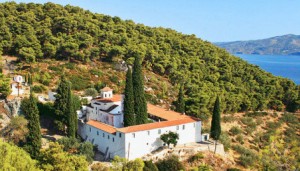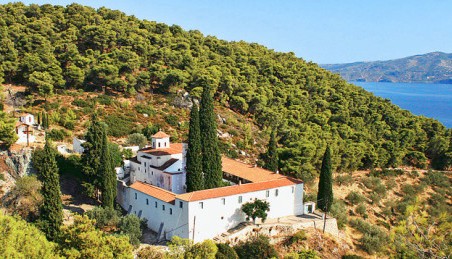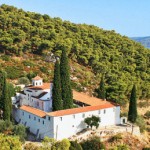Founded in the early 18th century, the Monastery of Zoodohos Pigi hovers above Kalavria, sandwiched between layers of velvet green pines and silk blue sky and sea. The retreat is dedicated to the “life-giving source,” believed to be a natural spring nearby whose waters are credited with healing the monastery’s founder, then Bishop of Athens Iakovos. The monastery is about 8 kilometers from Poros Town. The road leads directly to the gates of the monastery, where locals regularly attend services. A small flight of ramped steps leads to the main complex and a deck with a stunning view of the Peloponnese coast, including the Lemonodassos, or Lemon Grove, across the channel. Inside the entry to the monastic compound, immodestly attired visitors are offered black robes to cover themselves. A small, high-domed chapel sits in the middle of the courtyard. It features a disproportionately large wood-carved iconostasis, framed on each side by two mid-19th century icons. A young Italian woman, who is buried on the monastery grounds, inspired the face of the Panayia depicted in one of the icons. Various local heroes from the Greek war of independence are also buried at the compound amid the tall cypresses.
Το Μοναστήρι της Ζωοδόχου Πηγής (18ου αιώνα), κτισμένο πάνω σε καταπράσινη πλαγιά, με θέα προς τη θάλασσα, αποτελεί δείγμα νησιωτικής μοναστηριακής αρχιτεκτονικής. Συνδυάζει τη γαλήνη με την απλότητα και τη γραφικότητα. Στην είσοδο της Μονής υπάρχει η φημισμένη πηγή για τις θεραπευτικές της ιδιότητες, από την οποία πήρε το όνομα της η Μονή στην πλευρά ενός χειμάρρου, κάτω από πανύψηλα πλατάνια, πάνω απο τη θάλασσα. Ιδρύθηκε και κατασκευάστηκε από τον Μητροπολίτη Αθηνών Ιάκωβο Β' με δική του δαπάνη και από διάφορες εισφορές κατοίκων του Πόρου. Ο ναός είναι τύπου Βασιλικής με τρούλο και στο εσωτερικό του εντυπωσιάζει το ξυλόγλυπτο τέμπλο που φιλοτεχνήθηκε στην Καππαδοκία της Μικράς Ασίας τον 17ο αιώνα και ο Επισκοπικός θρόνος. Το Μοναστήρι συνέβαλε πάρα πολύ στη στήριξη του ηθικού των κατοίκων κατά την περίοδο της τουρκοκρατίας και πέρασε δύσκολες στιγμές κατά την περίοδο της γερμανικής κατοχής, για να μπορέσει να συντηρηθεί και να στηρίξει τους κατοίκους.





